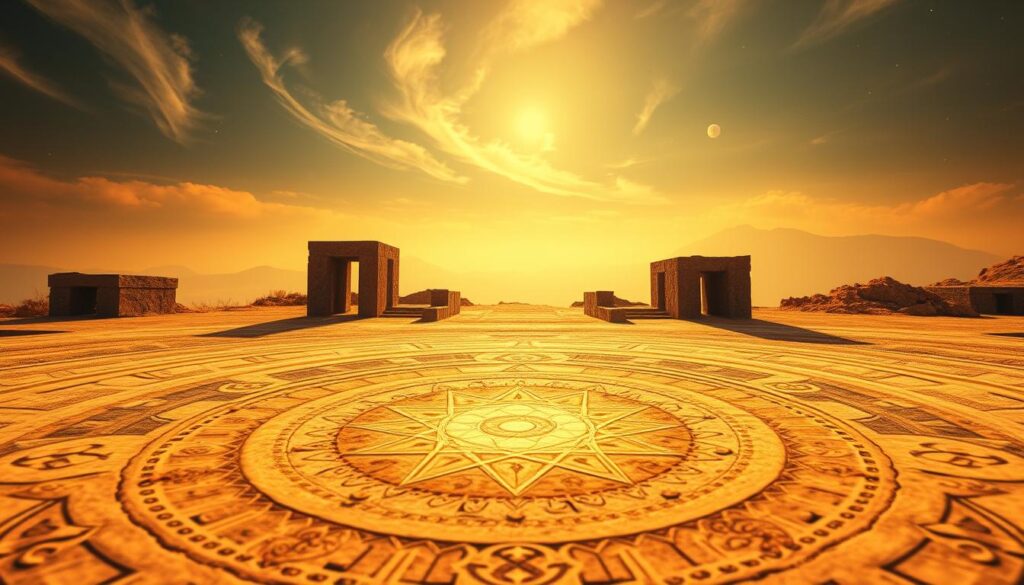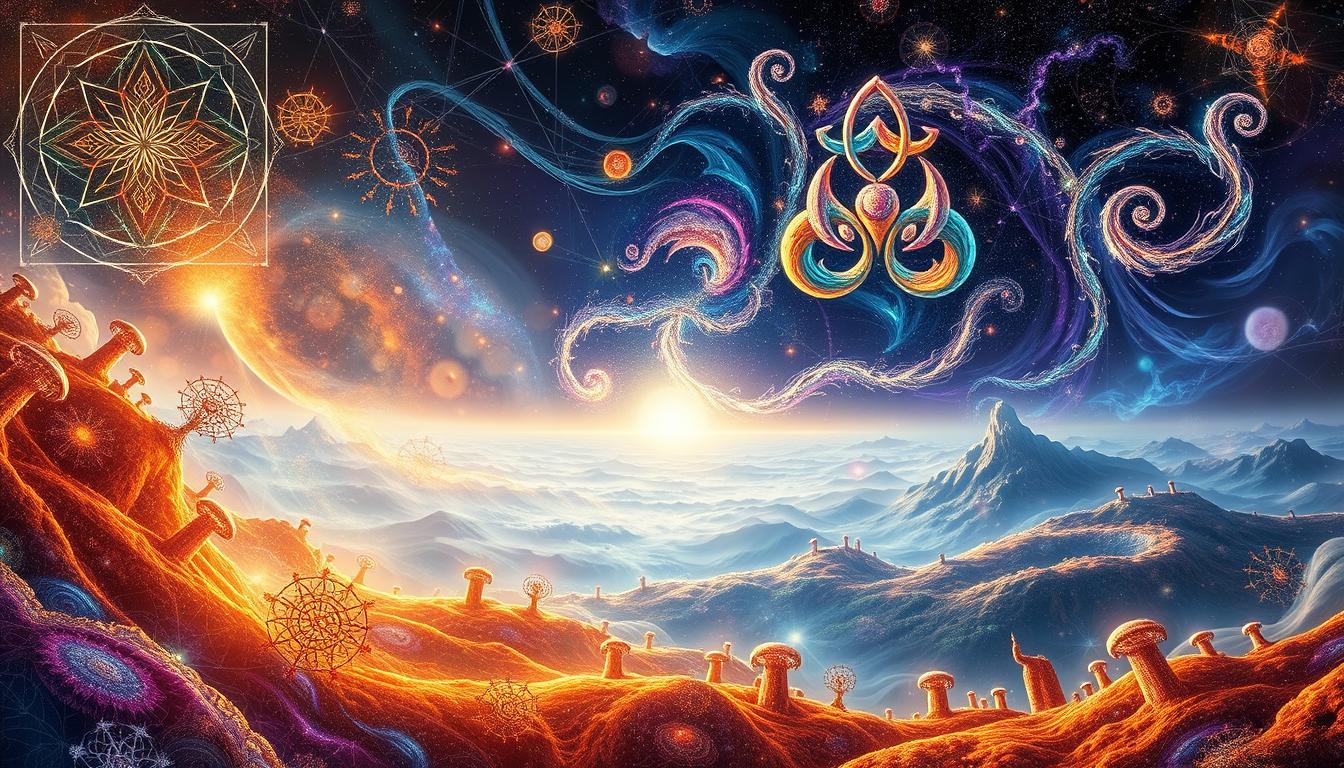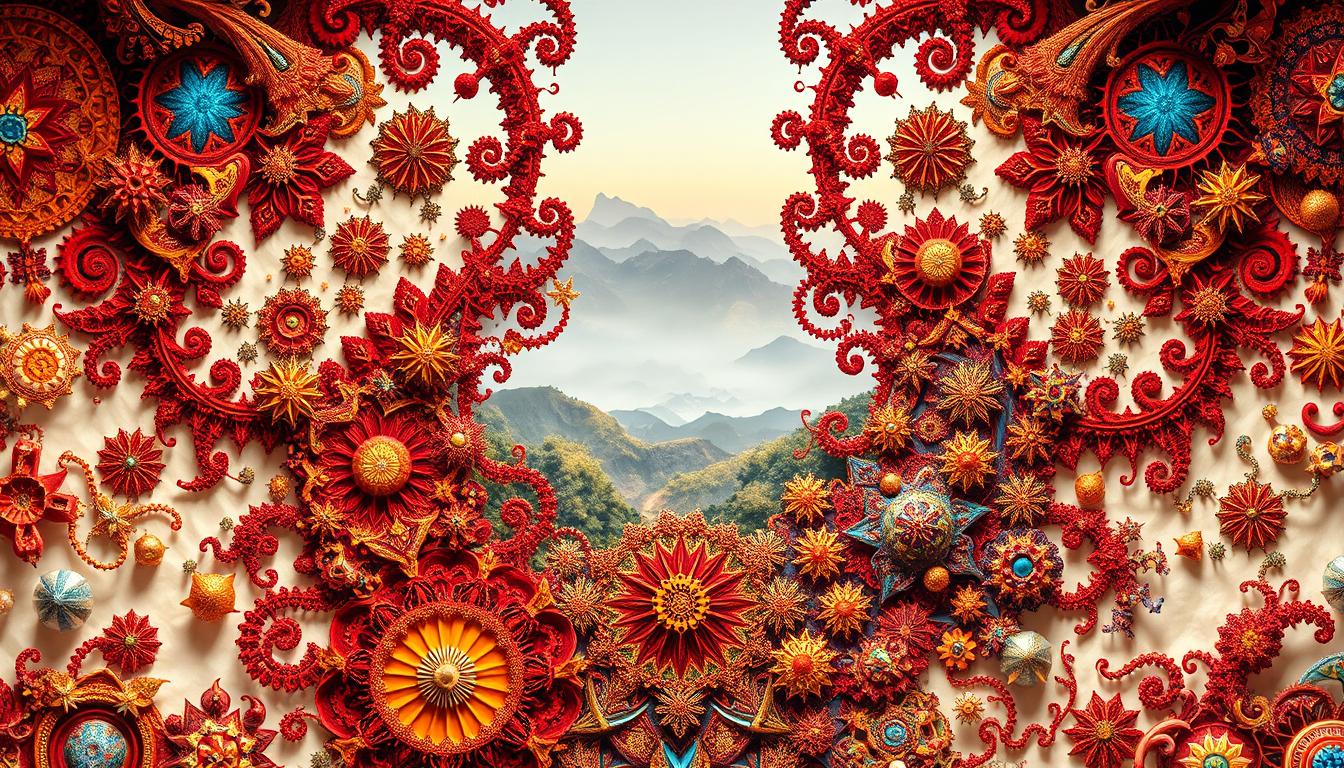Sacred geometry helps us see the bond between indigenous cultures and their lands. It shows the spiritual beliefs and identities of communities worldwide. Through geometric patterns, we discover how these societies view the world and cosmos.
These patterns appear in ceremony items and amazing buildings. They tell us about enduring values and philosophies of these cultures.
Introduction to Sacred Geometry
Sacred geometry is about understanding the universe through shapes and patterns. It shows how these forms are more than just math; they’re part of the spiritual and cultural life in many societies. Indigenous cultures see sacred geometry as a link between the physical and spiritual worlds. They believe that the patterns in nature show a greater truth.
In different indigenous cultures, sacred geometry appears in art, buildings, and rituals. Shapes like circles, triangles, and spirals have deep meanings, not just beauty. They reflect the people’s beliefs and values. This world of geometric symbols opens up ways to see our connection to the universe more clearly.

The Significance of Geometry in Ancient Civilizations
Geometry was vital in shaping ancient civilizations. It was the mathematical language that expressed cultural values and beliefs. By exploring geometry’s connection to cultural identity, we gain insights into peoples’ spiritual beliefs and community ethos.
The Role of Geometry in Cultural Identity
Geometry was more than just practical for ancient cultures; it signified who they were. Pyramids in Egypt and ziggurats in Mesopotamia showcased community values and connections. This geometric precision created a unique architectural language, revealing each society’s history and traditions.
Geometry as a Reflection of Spiritual Beliefs
Temples and sacred sites often featured geometric designs that symbolized spiritual beliefs. These designs linked the physical world with the cosmic, reflecting a deep cosmic understanding. Ancient builders used geometry to express and honor spiritual beliefs, aligning structures with celestial bodies.
Understanding Sacred Geometry in Indigenous Cultures
Exploring sacred geometry shows us how deeply indigenous cultures connect with nature. They noticed that nature’s patterns look a lot like geometric shapes. This helps us see how alive everything is, in a harmonious and complex way.
Connections Between Geometry and Nature
Looking at nature, people found inspiration in shapes for sacred geometry. Shapes like circles, triangles, and spirals are common in many cultures. They mean important life aspects.
- Circles often represent eternity and the cyclical nature of life.
- Triangles can signify harmony between the earth, sky, and humanity.
- Spirals illustrate growth, evolution, and the continuous journey of life.
These shapes show up in art and buildings, showing how cultures see the universe. It helps people feel closer to their world. It shows we are all one with nature.
Symbolism Behind Popular Geometric Shapes
Every shape has deep symbols in indigenous cultures. These shapes are not just to look at. They have deep meanings about life, the universe, and nature. For instance:
- The square symbolizes stability and grounding, often used in community spaces.
- The hexagon reflects balance and harmony, frequently found in natural beehives.
- The pentagram connects to spiritual elements, representing the five elements of nature.
Knowing what these shapes mean helps us understand indigenous peoples’ view of the cosmos. It shows how everything in life is connected through sacred geometry.
The Engineering Marvels of Indigenous Architecture
Indigenous architecture shows amazing engineering feats that mirror the creativity and flexibility of different cultures. These buildings were practical and also held deep spiritual and cultural meanings. One such impressive example is Ingapirca in Ecuador.
Case Study: Ingapirca in Ecuador
Ingapirca stands as a remarkable example of indigenous architecture, with its well-planned geometrical shapes. It showcases the builders’ deep knowledge of construction and their ability to align with the environment. The design of Ingapirca highlights a clear organization of space. This boosts the connection between humans and the universe around them. It features:
- Intricate masonry techniques
- Functionally-oriented design
- Astrological significance in placement
These features show the Inca civilization’s advanced understanding of geometry and its cultural significance. Ingapirca is a symbol of how indigenous architecture can blend practical use with spiritual meaning.
The Architectural Techniques of Mound Builders
The mound builders in North America used unique architectural methods that show their keen understanding of geometry and the landscape. Their earthworks were varied in size and purpose, demonstrating an impressive way to use earth in construction. Their architecture’s key points include:
- Use of local materials like soil and clay
- Complex mound shapes and sizes, serving various purposes
- Integration of natural features into their designs
Their construction skills showcase the mound builders’ engineering knowledge and precision. It shows their deep connection with the environment and the role of geometry in making lasting structures.
Sacred Geometry in Native American Cultures
Native American cultures have a deep connection to sacred geometry. It’s seen in their art and religious rituals. These geometric patterns are important symbols. They relate to life and the universe.
Geometric Patterns in Native American Art
Native American art is full of geometric patterns. These patterns reflect nature and spiritual beliefs. They appear in pottery, textiles, and beadwork. This showcases the identity of different tribes.
Each pattern has its own meaning, blending beauty with spirituality. Artists use these patterns to tell stories and keep traditions alive. This makes geometric patterns key in Native American art.
Symbolism of Geometric Shapes in Ritual Practices
In rituals, geometric shapes have special meanings. They connect people to their ancestors and the universe. Circles, squares, and other shapes symbolize important elements. Like the circle of life or the four cardinal directions.
These shapes are used in spiritual practices. They help create a sacred space. This strengthens the connection to the divine. It also brings people together.
The Influence of Geometry on Spiritual Practices
Geometry is crucial in spiritual practices. It shapes sacred spaces’ design and feel. Geomancy focuses on earth’s energies and their effect on these spaces, fostering spiritual connections. People use geometry to make places that match higher consciousness levels.
Geomancy and Sacred Spaces
Geomancy helps determine where sacred spaces go. Their layout is based on the idea that shapes affect spiritual vibes. These areas often include nature, following balance and harmony rules.
Important geomancy features in sacred places are:
- Alignment with stars and planets
- Shapes that connect with spiritual stories
- Blending in the natural environment to boost energy flow
Geometry in Ceremonial Objects
Ceremonial objects follow strict geometry. These items, like masks or altars, are core to spiritual rituals. Geometry helps show their deeper meaning.
Key geometry aspects in these objects are:
- Sacred shapes that bring out spiritual forces
- Balance and measurements showing cosmic correctness
- Choosing materials that elevate their sacred purpose
Cross-Cultural Perspectives on Sacred Geometry
Exploring sacred geometry shows how different cultures connect. By looking at the geometric practices of indigenous cultures and ancient Greek geometry, we find common themes. These themes show how societies see their world. Geometry isn’t just about shapes; it often means more spiritually across many traditions.
Comparative Analysis: Indigenous and Ancient Greek Geometry
Indigenous cultures see geometric forms as symbols of their bond with nature and the cosmos. Meanwhile, ancient Greek geometry laid the groundwork for math, philosophy, and art. Both cultures used geometry to share complex ideas and beliefs. This shows a deep symbolism that links them.
Similarities in Symbolism Across Cultures
Ancient Greek geometry and indigenous expressions both deeply value the symbolism in shapes. Circles often mean eternity and wholeness in indigenous cultures. Greeks saw similar meanings in circles and triangles. These similarities reveal geometry as more than science. It’s a universal language, connecting spiritual and physical worlds across cultures.
Case Studies of Sacred Geometry across Indigenous Cultures
Looking into sacred geometry helps us understand different indigenous cultures. This section shows us how these geometric patterns and stories are part of their culture. They show a deep bond with the earth and the stars.
The Patterns of the Pueblo Peoples
The Pueblo Peoples offer an interesting example of sacred geometry in their buildings and rituals. These groups live in the Southwest United States. They use geometry in everything from their homes to their art. Their buildings also line up with stars and planets, showing a deep connection to the sky.
Geometry in the Earthworks at Poverty Point
Poverty Point in Louisiana is a key site for sacred geometry. It has earthworks with amazing geometric accuracy. The shapes and mounds point to certain directions, showing advanced geometric knowledge. These patterns tell us about their society and beliefs, linked to their bond with the land.
Modern Interpretations of Sacred Geometry in Indigenous Contexts
Today, the ancient principles of sacred geometry still impact indigenous cultures. Artists and architects use this knowledge in new ways. This blend of old and new showcases our cultural roots and sparks innovation.
Artistic Expressions and Contemporary Applications
Modern artists love to use geometric designs from indigenous traditions. These designs do more than just look good. They carry important cultural stories and meanings.
- Use of geometric patterns in visual arts to convey spiritual narratives.
- Integration of sacred shapes into fashion and textile design, reviving traditional techniques.
- Public art installations that emphasize the unity of nature and human experience through geometric forms.
Reviving Ancestral Knowledge in Modern Architecture
Modern architecture is getting inspired by ancient wisdom. It uses sacred geometry to make spaces that are both useful and spiritually meaningful. Here are some ways this is happening:
- Designing urban environments that reflect harmonious relationships with nature using geometric principles.
- Incorporating sustainable materials shaped by traditional geometric patterns that echo indigenous philosophies.
- Creating community spaces that foster connection through the use of sacred shapes in architectural layouts.
Sacred Geometry in Indigenous Cultures
Sacred geometry shows deep thoughts of indigenous cultures about life and the universe. By looking at geometric patterns, we understand their view of nature and the cosmos. This wisdom is not just about math but also spiritual values passed down through time.
The Interrelationship Between Human Existence and the Universe
This connection appears in many ways, showing sacred geometry as a symbol of life’s cycles. Indigenous cultures see the universe as a united whole. Geometric shapes represent life’s complexity and unity. This view respects nature and suggests living in harmony with the universe.
Harnessing Ancient Wisdom for Today’s Design Principles
Ancient knowledge is vital in today’s design, inspiring sustainability and spiritual values. Using sacred geometry, designs today aim for harmony with nature. This approach emphasizes designs that understand the universe, beyond just working well.
Conclusion
Exploring sacred geometry shows its deep meaning in different areas of life. We’ve seen how special shapes connect the physical and spiritual worlds. They show the beliefs of these communities.
Each shape not only stands for cultural identity but also a love for nature and the stars.
Sacred geometry is more than just pretty designs; it holds ancient knowledge that is still relevant. Indigenous people mix geometry with their traditions, making it key to grasping life. Today, as we try to find these basic truths again, the value of sacred geometry grows. It inspires architects and artists to make work that has more depth.
In the end, learning about sacred geometry helps us see the big effect indigenous cultures have. By valuing these geometric traditions, we honor their history. We also help blend old wisdom with today’s world.



